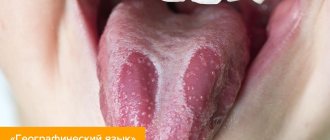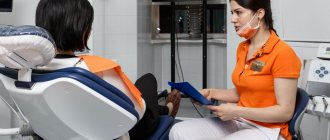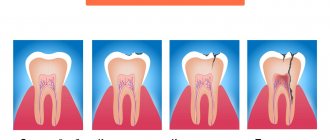How to treat a fistula
The concept of fistula implies an open channel between any organ and the surface of the body, otherwise it is also called a fistula.
As a rule, a fistula forms as a result of a complication after surgery or an advanced disease. Fistula can only be treated surgically; only granular fistulas can heal on their own. What types of fistulas are there:
Rectal, rectovaginal, duodenal, bronchial, gastric. Based on its shape, the fistula can be complete or incomplete.
What are the causes of fistula
- tuberculosis, Crohn's disease;
- actinomycosis;
- tumors;
- paraproctitis;
- surgical intervention;
- diseases of ENT organs;
- Dental complications.
Causes of a fistula on the gums in an adult
A fistula is formed due to an infectious purulent process in the dental canal. Pathology can occur for the following reasons:
- Deep caries and untimely treatment;
- Newly emerging periodontitis and periostitis with the formation of pus;
- Chronic periodontitis, damage to the walls of the tooth root;
- Cystic formations;
- Oncology;
- Pulpitis, damage to the tooth root;
- Granuloma.
Fistula also occurs after tooth extraction. This is a common pathology that occurs as a result of infection in the wound.
A fistula after dental treatment can form, for example, due to infection as a result of errors in the treatment of caries. Improper filling of a tooth can also lead to the development of pathology. In this case, a tooth root fistula is formed when pus, having passed through the dental canal, breaks into the surrounding tissue. The most common fistula of the upper and front teeth occurs.
Alcohol, smoking, stress, exacerbations of chronic diseases, abuse of carbohydrates, lack of nutrition, chronic diseases - all these factors increase the root causes of the disease.
Symptoms of the disease
General characteristics:
- the temperature rises to subfebrile;
- lack of appetite;
- weakness;
- pain;
- the presence of various discharges from fistulas.
Rectal fistula:
It occurs as a result of paraproctitis, it can be intra, trans, extrasphincteric.
The symptoms of the disease are as follows:
- hyperemia of the skin around the anus;
- pain in the anus area;
- bowel dysfunction;
- the presence of discharge from the rectum of various types (pus, mucus);
- deformation of the anus;
- sphincter functions are impaired.
Diagnostics
If you experience similar complaints, you should contact a specialist as soon as possible. After the examination, the doctor will accurately establish the diagnosis and choose the optimal treatment method, as well as determine the need for urgent surgery. Additional instrumental studies may also be required if the diagnosis is unclear and other pathologies have been excluded.
In the case of acute paraproctitis or abscess, surgical treatment should be carried out as soon as possible, so the doctor will suggest that you undergo only the most necessary studies and tests that will not delay the operation.
Outside of the acute period, you will need to undergo standard examinations and tests for hospitalization, as well as additional tests such as MRI and pelvic ultrasound. This will help the doctor determine the extent of the disease, predict the extent of the operation and choose the most appropriate technique.
At the initial appointment, after collecting complaints and medical history, the doctor begins an examination of the perineum and a rectal digital examination. The external fistula opening is quite easily visualized in the perineum, buttocks or near the anus. The doctor can palpate the internal fistula opening only during a rectal digital examination of the rectum or anoscopy. In order to assess the course of the fistula and its location relative to the sphincters, to determine the presence of leaks or additional passages, an MRI of the pelvis is performed. Also, during the examination, the doctor assesses the functionality of the anal sphincters and, if necessary, anal manometry can be prescribed, which will accurately determine the functional state of the sphincters.
To exclude rectovaginal fistulas, which connect the vagina and rectum, women also undergo a vaginal examination.
In some cases, for the differential diagnosis of other diseases of the rectum, and especially for patients over 45 years of age who are at risk of intestinal cancer, a colonoscopy is required.
How to treat a fistula
Treatment of a fistula involves surgery. Drug treatment is used to relieve symptoms and speed up rehabilitation after surgery.
What types of surgery are used?
- laser cauterization;
- excision, followed by plastic surgery;
- excision followed by suturing;
- ligature method;
- fistula filling.
For what diseases is surgery contraindicated?
- infectious diseases;
- deterioration of general condition;
- blood clotting disorder;
- decompensation of chronic pathologies.
Treatment
Patients with diagnosed rectal fistula are prescribed surgical intervention. It is impossible to get rid of the pathology with the help of conservative therapy. During the operation, experienced proctological surgeons at the Yusupov Hospital excise the fistula and eliminate the internal opening.
For each patient, a unique treatment tactic is developed taking into account the localization of the fistula tracts, the nature of scarring, the presence of infiltrates and abscesses along the fistula in the cellular space and pararectal area, as well as many other individual factors.
When choosing a method of surgical treatment, the nature of the rectal fistula, the duration of its existence and the presence of inflammation are taken into account.
Patients in the proctology department of the Yusupov Hospital are primarily prescribed anti-inflammatory and antibacterial therapy; it is also necessary to rinse the fistula cavity. After the acute symptoms subside, they begin surgical intervention, during which the fistula tract is excised, the fistula is dissected, and the fistula opening is closed using various methods.
The use of an innovative technique is highly effective - sclerotherapy, during which solutions are introduced into the lumen of the fistula, thanks to which the walls of the fistula stick together and close.
Thanks to the use of basic and modern techniques, the availability of the latest medical diagnostic equipment and extensive practical experience, doctors at the proctology department of the Yusupov Hospital manage to achieve impressive results in the treatment of patients with incomplete rectal fistula. Each patient of the clinic undergoes high-quality diagnostics, an individual treatment regimen is developed, and the progress of the rehabilitation period is monitored.
When performing all medical procedures, painkillers are used; in difficult cases, anesthesia is used, so before visiting the doctor’s office, patients are devoid of fear and do not experience pain during the procedures. The clinic has all the necessary medical equipment, including the latest generation laser equipment.
The popularity of the Yusupov Hospital in Moscow is determined by its fair pricing policy, highly qualified doctors, and the sensitivity and friendliness of all medical staff.
How to treat a fistula after its removal
Inpatient treatment lasts a week. The patient is prescribed bed rest, special dietary nutrition, painkillers, as well as antibiotics to prevent bacterial infection, and, if necessary, laxatives.
Local therapy involves baths with an antiseptic solution.
With timely treatment, the prognosis is very favorable, the recovery period is 7-10 days, after which the patient can live as usual.
Our medical center will be happy to help patients with this problem; we have innovative equipment for surgical intervention. The price for examination and treatment of a fistula may vary depending on the chosen method; it can be clarified with our manager. Reviews from satisfied patients are very positive and indicate trust in our clinic and doctors. Do not delay in seeing a doctor, take care of your health.
Symptoms of a fistula: how dangerous is it?
Fistula manifests itself with a number of symptoms:
- unpleasant odor from the mouth;
- tooth mobility;
- feeling of foreign taste;
- mucous membrane is bluish or, conversely, pale in color;
- discharge of purulent mucus, often with blood;
- painful sensations during mechanical contact (chewing food, drinking hot drinks, brushing teeth).
The disease may also be accompanied by symptoms not directly related to the oral cavity. It is manifested by such signs as apathy, general weakness, and fever.
Despite the small area affected, the fistula poses a certain health hazard. Thus, purulent discharge can penetrate the lymph or blood, which will lead to diseases of the internal organs, pathological processes in facial tissues and even loss of teeth. Therefore, even at the first relatively mild symptoms, it is important to consult a doctor.
It is worth keeping in mind that the disease is asymptomatic for a very long time. Moreover, if treatment is delayed, this can lead to partial death of the periosteum. And then the patient will have to remove not one, but several teeth at once.
Paraproctitis: insidious fistula and false shame
This disease is one of those that people are embarrassed to discuss with friends and acquaintances. Moreover, the visit to the doctor is delayed from day to day. What can I say - it’s a shameful place, and that’s all... The disease is insidious with both severe physical pain and moral suffering. But this, unfortunately, is not all - without timely treatment, paraproctitis can poison a person’s life for many years, ultimately resulting in very dire consequences. And all because it was once awkward to cross the threshold of a proctologist’s office.
Anatoly Ivanovich Vanin, the head of the proctology department of the polyclinic of the Medical Center of the Administration of the President of the Russian Federation, Candidate of Medical Sciences, tells us why paraproctitis is dangerous and how to cure this disease - successfully and without false shame.
“Let me remind you that “para” in Greek means near, around, and proctitis is inflammation of the mucous membrane of the rectum,” said A.I. Vanin. — Thus, paraproctitis is an inflammatory disease of the tissue surrounding the rectal area, the lower part of the rectum.
The main reasons are stress, a decrease in the body's immune defense, a sedentary lifestyle, excessive use of antibiotics, severe hypothermia, nutritional errors, most often dry food, on the go, and as a result - constipation or, conversely, loose stools. Paraproctitis occurs regardless of age, but more often in men, because they smoke a lot and drink often. However, recently more and more women and girls are becoming ill: the desire to wear tight-fitting trousers, especially jeans made of thick, coarse fabric, as well as underwear, which, cutting into the crotch, injures the skin, is affected. Such abrasions become susceptible to infection, including viral infections. When hypothermia occurs - this is when girls flaunt in short skirts and thin tights in cold weather - herpes appears, which also provokes paraproctitis. Elderly people usually suffer from chronic paraproctitis if they suffered an acute form of the disease in their youth.
How does the disease occur? In the lower part of the rectum (in the anus) there are mucous glands that moisten the surface of the intestine with their secretions, facilitating the exit of feces if it is dry. With constipation, the mucous membrane is damaged, abrasions and cracks form, which become infected. Let me note that one gram of feces contains millions of units of different flora. This is where all the trouble begins.
The same thing happens when the stool is liquid - the acidic mass causes loosening of this area, also with possible infection. And even with normal bowel movements, something similar is possible - there seem to be no special complaints, but the body is weakened, and then the person just ate hot sauce, mustard, horseradish. The mucous membrane instantly becomes irritated and burns occur. The disease then develops according to a well-known scenario: the infection, along with inflammatory manifestations, spreads to the perirectal tissue - the connective tissue surrounding the rectum.
Paraproctitis begins with itching and slight discomfort in the anal area, then the disease gains momentum, purulent streaks form, which can turn into various fistulous forms and break out to the surface of the skin. If there is no breakthrough, the purulent mass comes out along with mucus and other unpleasant putrefactive discharges through the anus. Acute paraproctitis develops suddenly: the temperature rises, sharp pain appears in the rectal area, giving no rest, and after a sleepless night the person consults a doctor. True, there are erased forms of the disease - the patient does not seem to complain of severe pain, but the inflammatory infiltrate is palpable. In this case, to make an accurate diagnosis, you need to do an ultrasound, computed tomography or magnetic resonance imaging. A blood test alone is not enough, since the picture may be normal, although leukocytosis is sometimes observed.
In the chronic form of paraproctitis, fistulas do not heal for a long time. And then smears are taken from the patient to determine the cause of this protracted process, since the fistulous form of chronic paraproctitis can be caused by tuberculosis, syphilis, cancer, Crohn's disease, and other diseases. But more often the banal fistulous form is affected - with the release of E. coli and pus.
There are also internal incomplete fistulas, when the infection enters the anal fissure. Inflammation of perifocal tissue leads to abscess formation. The pus cannot come out due to the very dense thick skin. In this case, it is necessary to open and drain the abscess. If pus comes out through the internal opening of the fistula, then the discharge comes from the anus. Fistulas are located differently in all patients. In some - 2-3 cm from the anus - they can be felt with your fingers, seen in the mirror, in others - in the upper parts of the rectum.
The most common treatment for paraproctitis is ichthyol ointment and suppositories. They reduce tissue tension, relieve pain, help patients adapt to their condition; some even refuse surgery.
Initially, we try to puncture the abscess - release the pus, and then relieve the inflammation. The fistula is washed with a 1% dioxidine solution, and at the same time the patient is prescribed an anti-inflammatory drug - sumamed (0.5 g once a day for 3 days in a row). Fistula lavage is performed on an outpatient basis. Typically, after three procedures, the fistula closes in most patients. This is followed by taking medications that support the immune system.
But it happens that the fistula remains, however, without obvious purulent discharge. Treatment continues at home. Sitz baths are recommended: 1 tbsp. spoon of sea salt and baking soda per 5 liters of warm water. The duration of the bath is 10 minutes. Such procedures help the discharge of pus and clean the fistula well. After the bath, suppositories or ultraproct ointment are introduced. You can make microenemas from mumiyo: dissolve 1 tablet in 0.5 cups of hot water, administer warm.
I’ll tell you about one amazing case of recovery, which was helped by... a honey fair organized by Moscow Mayor Yuri Luzhkov in Manege. The patient came to us for procedures for a whole month, and to no avail: there was no pus, but the fistula remained. Here we just received information from this fair about the healing properties of sweet clover honey. They began to give the patient microenemas - 1 tbsp. a spoonful of honey in 0.5 cups of water. And everything healed in two days. Just a miracle!
I must note that such enemas - both with honey and with propolis oil solution - are very effective. The intestine even begins to squelch with pleasure: she likes warm, sweet things so much! Microclysters (1 tablespoon per 0.4-0.5 glasses of water) are done at night, and in the morning after stool, UltraProct suppositories are administered.
Sometimes you have to wait a long time for the abscess to break through. Then we recommend using the same ichthyol ointment, cakes made from baked onions, potatoes, and carrots. They help the fistula break through and pus drain. The patient chooses which flatbread is better, as they say, “at random” - whichever works more effectively, he “cooks” from it.
When all methods of conservative treatment have been exhausted, but the disease does not go away, we refer the patient for surgery, of course, if there are no contraindications. It is called Gabriel's operation, named after the surgeon who first performed it: a speculum is inserted into the anus, the mucous gland and fistula are excised. The treatment is very radical. True, scars appear after it, and even with hard stool, the lack of mucus causes certain inconvenience. Therefore, we try to injure this area as little as possible and, if possible, operate in extreme cases. It is better to use folk remedies and be observed at the clinic for a year. If the fistula heals, you can forget about the operation for decades.
However, frequent recurrences of the fistula are a big risk factor for oncology. Therefore, the patient must undergo an annual medical examination or examination by a surgeon. As a rule, such prevention is justified. During this period, one should not forget about maintenance therapy: make baths, lotions, pads, microenemas, follow a diet, especially for those who suffer from constipation and hemorrhoids. Here are some recommendations.
- As a laxative, drink 1 glass of freshly prepared carrot juice with pulp on an empty stomach. For hemorrhoids, steam and drink carrot tops as tea.
- Juice from ripe rowan berries - 0.5 cups of Zraz a day before meals. Apply the remaining pulp to the hemorrhoids in the form of a compress.
- Drink a mixture of carrot and spinach juices in a ratio of 10:3 3 times a day before meals. The daily dose is 2 glasses.
- Sauerkraut brine - 1 glass 3-5 times a day before meals for hemorrhoids, constipation and heavy bleeding.
- Grate raw potatoes with peel, squeeze out juice, 1 tbsp. Inject a spoonful of juice into the anus with a syringe at night. The course of treatment is 10 days.
- Consume 100-150 g of boiled red beets on an empty stomach for chronic constipation and digestive disorders. For spastic constipation, a salad made from boiled beets and vegetable oil is useful - also on an empty stomach.
- For prolonged constipation, beet broth is used for enemas: pour 20 g of beets with 2 glasses of water, boil for 30 minutes.
- Pour boiling water over washed prunes in the evening. In the morning, eat a few plums on an empty stomach and drink the resulting liquid (without sweetening it) as a laxative.
- Warmed water from pickled lingonberries, taken on an empty stomach, is also a good laxative.
Badger and bear fat are effective in treating the rectum. Turundas or tampons should be soaked in fat and inserted into the anus overnight. If the mucous membrane of the anal canal is erosive, you can make thin sticks from fresh potatoes rich in starch. It envelops well, relieves irritation, heals erosions and cracks in the anal rectum. The sticks are inserted overnight.
Now - about mucous glands and mucus. I am convinced that the removal of any organ, including mucous glands, is an intervention in nature: there is nothing superfluous in the body. However, if the glands are constantly inflamed, their excision is a necessary and necessary measure.
Sometimes patients complain of copious mucus secretion. However, in this way not only inflammatory processes of the mucous glands can manifest themselves, but also concomitant diseases. For example, the growth of mucous membrane in the intestine, like a villous tumor, which produces up to one liter of mucus per day, secreted through the rectum. And although the tumor is benign, the body, in fact, begins to rot. Villous tumors can occur in the rectum and in the overlying intestines. The literature describes a case where the colon was completely affected by it. Therefore, copious mucus discharge should definitely alert you. Often, patients are frightened mainly by the release of blood.
Excessive mucus, when it, as we say, comes out in “buckets”, and with blood, can also occur with ulcerative colitis, most often caused by stress and other reasons. Patients with ulcerative colitis should be observed by a gastroenterologist for at least 10 years: colorectal cancer may develop.
Concluding the conversation, I will say that the specialty of a proctologist is now, alas, gaining power and strength, since many of our diseases depend on the state of medicine and society, and a person’s attitude towards his health. Of course, we are far from Japan, where they thought of, for example, installing special sensors on toilets that detect the presence of blood or mucus in flushed feces. A dispatcher is sitting in some Japanese housing complex and sees on the instruments: in such and such an apartment one of its residents has intestinal problems. He comes and says: someone is sick. And doctors begin to check the whole family.
Many of us are embarrassed to see a doctor in a timely manner - they delay until they press properly. Why be ashamed? If there is slight itching or mucous discharge, you need to go to the clinic. As a last resort, at least tell your loved ones about the unpleasant sensations - this will make it easier to overcome false shame and begin treatment. Paraproctitis and its consequences - fistulas - are completely curable when time is not lost in doubt and torment.











